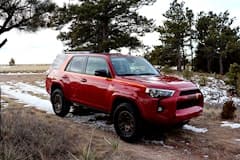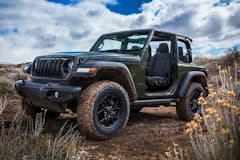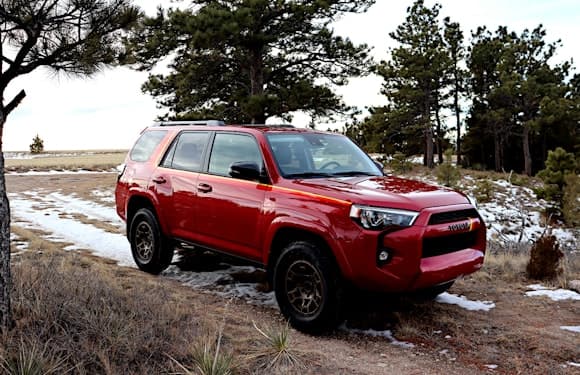
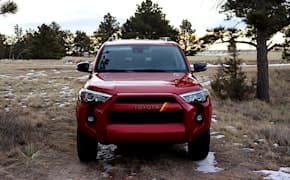
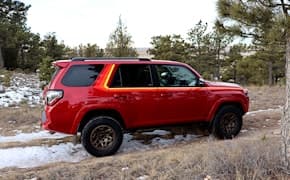
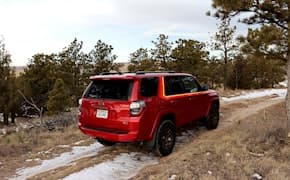

Show all photos
Summary
The 4Runner first debuted in the 1980s and was an immediate hit amongst buyers looking for an off-road sport utility vehicle. The current-generation 4Runner is now 13 years old in design, but sales are still strong for this truck-based SUV.
- Good off-road capability
- Sizeable cargo space
- Low fuel economy
- Thick truck-like ride quality
- Retro 40th Anniversary Special Edition
- Added standard safety equipment
Engine
Horsepower
MPG
Max Seating
Basic Warranty
Verdict - Is the Toyota 4Runner a Good SUV?
The Toyota 4Runner is a throwback SUV, especially in the new 40th Anniversary Special Edition package available this year. At 13 years old, the current design for the 4Runner is definitely outdated when compared to its rivals, but there is a lot of appeal in that age for many buyers.
The Toyota 4Runner is a truck-based, body-on-frame sport utility with several similarities to the mid-sized Toyota Tacoma pickup truck. The Tacoma, however, is built on a separate platform from the 4Runner and this SUV is one of the few that is made in Japan and imported rather than being built in the U.S. Part of the 4Runner’s appeal is its wide range of trim options that change the focus and use case for the SUV significantly between them.
Most of the value in the 4Runner itself is dependent on the buyer’s needs and use cases for this SUV. We recommend carefully considering each trim level and its inclusions before choosing any 4Runner purchase. But those who do so will likely greatly enjoy their Toyota.
The SR5 trims (SR5, SR5 Premium), 40th Anniversary Special Edition, and the higher-end TRD Sport and Limited trims are sport utilities focused on budgets and family hauling versus off-road or all-weather capability. These vary, in the order presented, in interior sophistication and comfort and are all available with rear-wheel drive or four-wheel drive drivetrains. Conversely, the TRD Off-Road, TRD Off-Road Premium, and TRD Pro models are 4WD-only and are equipped with increasingly higher and higher levels of off-road gear and the capabilities that those add.
All of that said, we do recommend considering other options that may add more family-friendly interiors, better on-road ride qualities, and better fuel economy by comparison.
Overall Car Talk Award
Car Talk researchers have tested this vehicle and decided to award it a 6.5 out of 10 based on our years of expertise and stringent criteria.
6.5/10
We have reviewed all of the following aspects of this vehicle.
6/10
6/10
4/10
Toyota 4Runner vs. The Competition
There are a few competitors to the 4Runner for off-road capability, such as the four-door Jeep Wrangler or the four-door Ford Bronco. Both of these options are, frankly, more off-road-ready than is the 4Runner in even its most off-pavement-focused configurations. The 4Runner is, instead, more closely competitive with crossover-SUV models in most of its configurations.
Toyota 4Runner vs Toyota Highlander
In every way that does not include off-road prowess, the Highlander is the better Toyota option compared to the 4Runner. It includes three rows of seating, much better fuel economy, a larger interior, and much better on-road dynamics. By comparison, the 4Runner is much more primitive and less ergonomic.
Toyota 4Runner vs Nissan Pathfinder
The Pathfinder was once the chief rival to the 4Runner as a 1980s off-road SUV. The two were often seen together on beaches and campsites around the country. The Pathfinder is now a unibody crossover with a much more on-road-focused design. It still has good off-road chops, but only in light and some medium-duty applications. The 4Runner has a higher ground clearance and beefier tires for more capability.
Toyota 4Runner vs Ford Bronco
Off the road, the standard model Bronco and the 4Runner are similar in many ways. The Ford has more clearances for getting around off the road when compared apples-to-apples. As trim levels (and prices) increase and more and more gear gets added, however, the Bronco soon outclasses the 4Runner in off-pavement capability. But the 4Runner can give it a run for its money and has similar on-road presence when compared.
Toyota 4Runner vs Jeep Wrangler
The Wrangler has often set the bar for off-road capability and the 4Runner rarely lives up to that. But the Toyota does have a better on-road feel and is more family-friendly in general. Like the Bronco, however, as higher packages with more and more off-road gear are added, the 4Runner begins to fall behind.
How Much Does a Toyota 4Runner Cost?
Starting price for the 2023 Toyota 4Runner is about $41,000 plus destination. Most buyers will likely be in the $50,000 range when purchasing a Toyota 4Runner.
The table below shows the most common trim levels and how much they will run you.
SR5
TRD Sport
SR5 Premium
TRD OFF-ROAD
TRD OFF-ROAD Premium
40th Anniversary Special Edition
Limited
TRD PRO
What's New for the Toyota 4Runner in 2023?
New additions for the 2023 model year are a retrolicious 40th Anniversary Special Edition and the addition of some safety items as standard equipment.
The 4Runner 40th Anniversary Special Edition is an 80s-inspired trim point based on the SR5 Premium model. It adds a unique grille, styling elements, bronze accents, and a sunroof. As well as the TRD yellow-and-orange striping popular on 1980s Toyotas. This is a limited production model available only for 2023.
The 2023 4Runner also comes standard with lane-departure warning and blind-spot warning with rear cross-traffic alerts. Previously, these were additional options with some trim packages of the 4Runner and are now standard on all models.
Performance - How Does the Toyota 4Runner Drive?
The 4Runner’s design was already considered fairly throwback when the current generation of the SUV debuted in 2010. So thirteen years on, it is very different from other, more current options on the road. The 4.0-liter V6 and five-speed automatic transmission combination is not very fuel efficient or adaptive. But they have a reputation for being long-lived and well-built.
Most drivers will likely come to the same conclusion we did, that the 4Runner is a bit old school in its drive quality and dynamics, but it holds its own in most situations on the road. Off the road, it’s not smoother or necessarily more competent than others in the segment, but it’s nothing to shake a stick at either. It’s more stable and better balanced than its retro design might make it seem to be.
In all cases, we’d say that the Toyota 4Runner strikes a middle ground between extreme off-road-focused options and the on-road cushiness of most other options. It’s quiet enough and comfortable enough on the road to be a daily driver, but capable and strong enough to go adventuring where there are no roads.
Safety - How Safe is the Toyota 4Runner?
The 2023 model Toyota 4Runner does not have NHTSA crash testing scores, but is a mechanical and design twin of the 2022 model year. Our numbers here are based on that assessment.
| Testing Body | Overall Rating | Advanced Systems |
|---|---|---|
| NHTSA | 4 Stars | Meets Requirements |
| IIHS | Moderate | Not Rated |
Reliability & Quality - Is the Toyota 4Runner Reliable?
Most consumer rating groups are giving the Toyota 4Runner an above average expected reliability. This is in line with Toyota’s overall reputation and award-winning reliability as a whole. The long history behind the current-generation 4Runner gives plenty of data to bolster that high expectation.
Toyota has a well-deserved reputation for making high-quality and long-lasting vehicles. So we have little reason to doubt that the 4Runner will live up to that expectation.
Features - What Toyota 4Runner Options Are Worth It?
We have two options that will fit most buyer’s needs with the Toyota 4Runner. For the buyer who will mostly be on-road and has only a few off-road needs, we’d recommend the SR5 Premium package with its nicer interior and amenities compared to the base model. This trim also gives access to the well-done 40th Anniversary Special Edition.
Buyers of the 4Runner looking for more off-road capability will likely find their sweet spot in the TRD Off-Road Premium package, which has a similar number of comfort additions as the SR5 Premium, but with more off-road gear such as a locking rear differential and available Kinetic Dynamic Suspension System (KDSS) for added wheel articulation off the pavement. For most off-road users, these additions are just what’s needed and nothing more and avoid the deep pockets requirement of the more hardcore TRD Pro model.
Exterior colors
Ice Cap
Magnetic Gray Metallic
Barcelona Red Metallic
Nautical Blue Metallic
Midnight Black Metallic
Classic Silver Metallic
Interior colors
Sand Beige, cloth
Black/Graphite, cloth
Warranty - What is the Toyota 4Runner Warranty?
Toyota’s warranty is standard on most of its models and covers the basics, as most of its competitors do. Most Toyota purchases also include up to three years of complimentary maintenance (oil changes, tire rotations, etc) as well.
- Basic: 3 years / 36k miles
- PowerTrain: 5 years / 60k miles
- Toyota offers good extended warranties for certified pre-owned cars
- If buying used look at our best extended warranties
 Toyota 4Runner | ||||
| Basic | 3 yr./ 36,000 mi. | 3 yr./ 36,000 mi. | 3 yr./ 36,000 mi. | 3 yr./ 36,000 mi. |
| Powertrain | 5 yr./ 60,000 mi. | 5 yr./ 60,000 mi. | 5 yr./ 60,000 mi. | 5 yr./ 60,000 mi. |
| Corrosion | 5 yr./ unlimited mi. | 5 yr./ unlimited mi. | 5 yr./ unlimited mi. | 5 yr./ unlimited mi. |
New or Used - Is Toyota 4Runner Worth Buying Used?
With the exception of those enamored with the new 40th Anniversary model (and who wouldn’t be?) of the 4Runner, used is probably the best option when buying this SUV. The deals and options and availability of used Toyota 4Runners are extensive. So finding a gently-used or well-loved (and cared for) 4Runner is not difficult.
